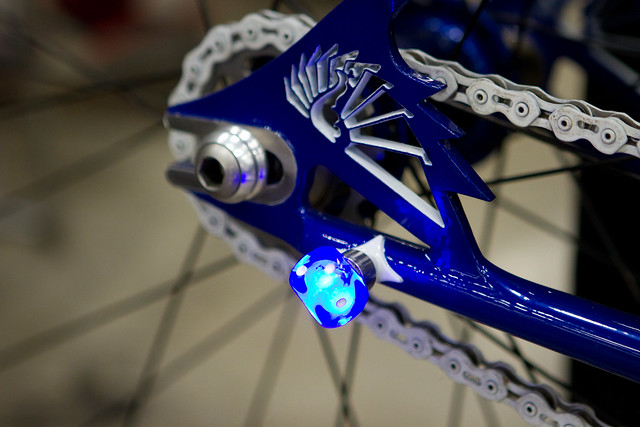There was some information on “my” Switzer family from a biography of Jacob Yarian and one of his son Jonathan Yarian. The full text of the biographies, including sources, can be read in the post mentioned above. Was it all true? Or were just parts of it valid? Below I've abstracted the basic information (shown in blue bold type) and what I've discovered (a combination of new info found in June at the Family History Library and old stuff) will be in normal black type.
One biography stated that Elizabeth Switzer was born near Lisbon in Columbiana County on September 23, 1815. The other one stated she was born September 24, 1815 in Columbiana County, Ohio.

Jacob and Elizabeth Yarian are buried in Randolph Hillside Cemetery in Portage County, Ohio. Their gravemarker shows that Elizabeth was born September 24, 1815 and died July 3, 1894. Jacob was born December 24, 1812 and died March 26. 1895.She married Jacob Yarian on April 2, 1835 in Columbiana County.
As far as where she was born, I haven't yet determined where exactly the family was living but it was in either Salem or Fairfield townships both of which are just north of Centre township. The town of Lisbon, is in Centre township.
Their marriage is recorded in Columbiana County Marriage book 3 page 48, and they indeed were married on April 2, 1835.

The marriage record of Jacob Yarian and Elizabeth Switzer. Cropped portion of image downloaded from FamilySearch database "Ohio, County Marriages" on May 28, ...Her parents were Jacob and Mary C. Switzer. Elizabeth was the oldest of their seven daughters.
The final settlement document in the estate file for Jacob Switzer (packet number 4962 dated November 7, 1859) named his heirs: his widow, Leathy Switzer; Jacob Yarian & wife; Jacob Monanack & wife; Peter Buckecker & wife, Daniel Deemer & wife. Marriage records of Columbiana County provided the first names of the Switzer daughters: Elizabeth married Jacob Yarian, Barbara married Jacob Manaweck, Rebecca married Peter Buckecker and Susan married Daniel Deemer. The names of the other three daughters, if there were that many, remain a mystery.One biography states that Jacob Sweitzer was born in Switzerland. He was reared in that country and at the age of 27 came to America, locating in Columbiana County where he secured a tract of timbered land and literally hewed a farm from the wilderness. The other biography says that Jacob and Mary C. Switzer were natives of Pennsylvania.
Leathy was Jacob's second wife. Columbiana County marriage book 38 page 168 shows that on March 10, 1853 Jacob Switzer was married to Leathy Bricker.
In Columbiana County marriage book 1 page 95 we find the record of the marriage of Jacob Switzer and Caty Brinker on February 26, 1811.
Confirmation that Caty Brinker was the mother of Elizabeth was found in a deed dated August 11, 1849 in which the heirs of Catherine Sweitzer were selling land that had been given to her by her father Andrew Brinker. (More on that discovery in a future post!)
The families of the four Switzer daughters have been found in census records through 1870 and it seems that Barbara was the oldest, being a year or two older than Elizabeth.
The 1850 census of Salem Township, Columbiana County (p280) shows Jacob Switzer and Catherine A. Switzer, both age 65 and both born in Pennsylvania. I'm fairly certain that this is “my” Switzer family since Daniel Deemer and his wife Susanna are listed immediately after Jacob and Catherine.Jacob and his wife survived to be old people. He passed away at the age of 87 and she at the age of 83.
According to Columbiana County Cemetery Inscriptions Volume 13, Jacob and Catharine are buried in the English Lutheran Cemetery in Salem Township. The transcription for Catharine says she was the wife of Jacob and that she died March 6, 1852 ae 64y 8m 17d. However, this puzzles me just a bit for two reason. First, Catherine was 65 years old in the 1850 census so either the census is wrong or the stone was difficult to read and mis-transcribed. Could the 4 in her age really be a 7? And second, the heirs of Catharine Switzer sold 213 acres of land on August 11, 1849 that had been deeded to her. Perhaps they were selling it on her behalf and simply releasing their claim to the land since it was sold for just $1 (one dollar) to Thomas McCoy. I have not yet researched to see if he is somehow related to them.
The cemetery transcription for Jacob Swettzer shows that he died November 2, 1859 ae 71y 9m 29d. As a side note, Jacob's second wife Leathy was also buried in the same cemetery. She died January 17, 1859 ae 79y 11m 25d.
Since I am approaching the age of 64 I can't really say that 64 is old ;-) but 79, yeah, I guess that's old. But neither Elizabeth nor Jacob reached the age of 83 or 87 as recorded in the biography.Jacob Sweitzer and Ephraim Holloway were brothers-in-law of Martin Hoke. They entered section 25 about the year 1804.
This is not “my” Jacob Switzer. A deed record dated January 20, 1832 shows Jacob Switzer and Elizabeth his wife selling 156 acres in the NE ¼ of S 25 T15 R3 to Daniel Switzer for $1500 and other considerations. This land was granted to Jacob Switzer by Patent. (Again, more on this Jacob and this transaction in a future post.)=+=+=+=+=+=+=+=+=+=+=+=+=+=+=+=+=+=+=+=
As with most family biographies published in county history books in the late 1800s and early 1900s there is some good/accurate information and some bad/inaccurate information. It is up to us, the family history researchers, to determine which is which!

 If I had the funds and influence to do so, I would love to sponsor a contest with precisely this goal in mind - but unfortunately, I don't think that knitted hats and the "honor" of being featured on Lovely Bicycle alone have sufficient pull to convince electrical engineers to spend their time working on such a project. If anybody in the industry is interested in getting involved as a sponsor, please do get in touch.
If I had the funds and influence to do so, I would love to sponsor a contest with precisely this goal in mind - but unfortunately, I don't think that knitted hats and the "honor" of being featured on Lovely Bicycle alone have sufficient pull to convince electrical engineers to spend their time working on such a project. If anybody in the industry is interested in getting involved as a sponsor, please do get in touch. 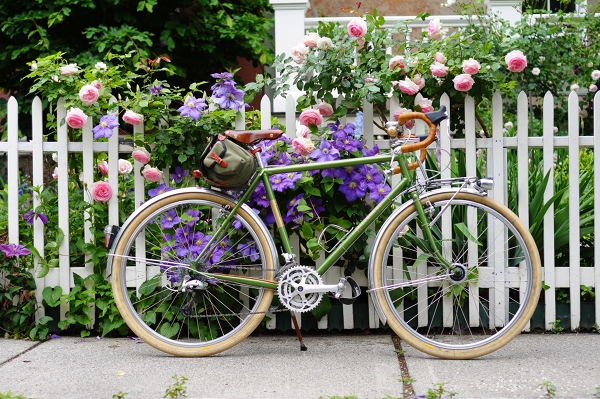 Last week I rode my RivendellSam Hillborne for the first time in three weeks after riding exclusively the loaner Seven on a close to daily basis. It's hard to believe that the body can adapt to one position so quickly as to find other positions unnatural. I confidently got on my bike, expecting that old familiar feeling of riding it to welcome me back. But I was in for a surprise. The ride was as comfortable as I remembered, but everything felt off. It took me a while to understand what was wrong. Initially it was just a vague sense of not feeling as connected to the road and as much in control of the bike, which was disconcerting. As I kept cycling, I became aware that it was really two specific things: I felt that I was seated too far back, and that I wasn't out far enough over the front wheel. I kept wanting to shove my weight forward, and it was frustrating to feel almost as if I were sitting "behind" the bike.
Last week I rode my RivendellSam Hillborne for the first time in three weeks after riding exclusively the loaner Seven on a close to daily basis. It's hard to believe that the body can adapt to one position so quickly as to find other positions unnatural. I confidently got on my bike, expecting that old familiar feeling of riding it to welcome me back. But I was in for a surprise. The ride was as comfortable as I remembered, but everything felt off. It took me a while to understand what was wrong. Initially it was just a vague sense of not feeling as connected to the road and as much in control of the bike, which was disconcerting. As I kept cycling, I became aware that it was really two specific things: I felt that I was seated too far back, and that I wasn't out far enough over the front wheel. I kept wanting to shove my weight forward, and it was frustrating to feel almost as if I were sitting "behind" the bike.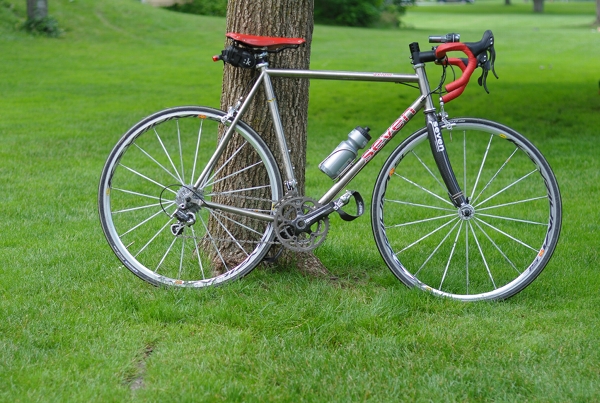 Looking at the way the two bicycles are set up, the difference makes sense. On the Seven, the saddle sits further forward and the handlebars are further out. I was aware of this difference before, but assumed that I would find the Seven's set-up aggressive and uncomfortable, while the Rivendell's set-up a welcome relief. Instead the Seven's set-up now feels "right" and anything deviating from it feels "wrong" - as if I don't have sufficient control of the bike. That feeling is hard to shake. I think my Rivendellneeds a little make-over.
Looking at the way the two bicycles are set up, the difference makes sense. On the Seven, the saddle sits further forward and the handlebars are further out. I was aware of this difference before, but assumed that I would find the Seven's set-up aggressive and uncomfortable, while the Rivendell's set-up a welcome relief. Instead the Seven's set-up now feels "right" and anything deviating from it feels "wrong" - as if I don't have sufficient control of the bike. That feeling is hard to shake. I think my Rivendellneeds a little make-over. While moving the saddle forward is easy enough, changing the handlebar set-up will be messy, because I will have to replace the fairly short (6cm) stem with a longer one. When I fist began trying to ride with drop bars, I found it extremely difficult and a short stem was recommended to make the transition easier. I cannot say that it was a poor recommendation, because it worked. I rode with this set-up for a year, gradually becoming more comfortable with the whole idea of a roadbike, and feeling increasingly natural in a forward-leaning position. Some would look at my bikes and point out that my stems are too short, and I was perfectly aware that by most standards they are. But these things are highly personal, and last year I was concerned not so much with speed and agility, as with just being able to ride the bike. The way a bike balanced with a shorter stem felt better to me at the time. For what it's worth, I see many roadbikes from the 1970s-80s that were ridden by women set up with short stems. My previously owned vintage Trek had an even shorter stem than this bike, and that was the original owner's doing.
While moving the saddle forward is easy enough, changing the handlebar set-up will be messy, because I will have to replace the fairly short (6cm) stem with a longer one. When I fist began trying to ride with drop bars, I found it extremely difficult and a short stem was recommended to make the transition easier. I cannot say that it was a poor recommendation, because it worked. I rode with this set-up for a year, gradually becoming more comfortable with the whole idea of a roadbike, and feeling increasingly natural in a forward-leaning position. Some would look at my bikes and point out that my stems are too short, and I was perfectly aware that by most standards they are. But these things are highly personal, and last year I was concerned not so much with speed and agility, as with just being able to ride the bike. The way a bike balanced with a shorter stem felt better to me at the time. For what it's worth, I see many roadbikes from the 1970s-80s that were ridden by women set up with short stems. My previously owned vintage Trek had an even shorter stem than this bike, and that was the original owner's doing. Going back and forth between the Sevenand the Rivendellhas been educational; each has what the other lacks. It is fairly clear to me that I "need" a lightweight, purely-roadish roadbike like the Sevenand that I also "need" a wide-tired, befendered, dynamo-hub, luggage-bearing long distance bike like the Rivendell. I would not want to turn one into the other, or to combine them into something in-between. If I could make changes to the Seven, it would be to magically decrease its size. If I could makechanges to the Rivendell, it would be to alter its positioning and to make it lighter. The former we will be doing shortly. The latter is not really possible without getting rid of the very things that make this bike practical. But I am very curious now whether it is the positioning, more than anything else that accounts for the difference in speed between the two bicycles. I am also wondering what the "ideal" stem length for this bike would be. The top tube is unusually long, so it would have to be 8-9cm tops. It's frustrating that experimenting with stems is not easy, but I will report the results of my trial-and-error fumblings.
Going back and forth between the Sevenand the Rivendellhas been educational; each has what the other lacks. It is fairly clear to me that I "need" a lightweight, purely-roadish roadbike like the Sevenand that I also "need" a wide-tired, befendered, dynamo-hub, luggage-bearing long distance bike like the Rivendell. I would not want to turn one into the other, or to combine them into something in-between. If I could make changes to the Seven, it would be to magically decrease its size. If I could makechanges to the Rivendell, it would be to alter its positioning and to make it lighter. The former we will be doing shortly. The latter is not really possible without getting rid of the very things that make this bike practical. But I am very curious now whether it is the positioning, more than anything else that accounts for the difference in speed between the two bicycles. I am also wondering what the "ideal" stem length for this bike would be. The top tube is unusually long, so it would have to be 8-9cm tops. It's frustrating that experimenting with stems is not easy, but I will report the results of my trial-and-error fumblings.

 Charles Romain Brubaker, my great grandfather, is buried in Machpelah Cemetery, Pascagoula, Jackson County, Mississippi next to his second wife, Viola Fagan Winters Brubaker Shattles. (His first marriage, which ended in April 1921, was to Maude Catherine Wise. They had four children, one of whom was Hazlette Brubaker, my grandmother.)
Charles Romain Brubaker, my great grandfather, is buried in Machpelah Cemetery, Pascagoula, Jackson County, Mississippi next to his second wife, Viola Fagan Winters Brubaker Shattles. (His first marriage, which ended in April 1921, was to Maude Catherine Wise. They had four children, one of whom was Hazlette Brubaker, my grandmother.) CHARLES R. BRUBAKER / SGT US ARMY / SP AM WAR WORLD WAR I / AUG 19, 1871 DEC 19, 1945
CHARLES R. BRUBAKER / SGT US ARMY / SP AM WAR WORLD WAR I / AUG 19, 1871 DEC 19, 1945 VIOLA FAGAN BRUBAKER / SHATTLES / AUG. 15, 1889 APR. 11, 1977
VIOLA FAGAN BRUBAKER / SHATTLES / AUG. 15, 1889 APR. 11, 1977
 Here is Tuffee, our Border Collie, Spanky the small brown dog, and Daisy the large white Great Pyrenees Pup. Yes she is only a pup and over 100 pounds. I think she was about 8 months old here.
Here is Tuffee, our Border Collie, Spanky the small brown dog, and Daisy the large white Great Pyrenees Pup. Yes she is only a pup and over 100 pounds. I think she was about 8 months old here.
 On a another note, Washington State D.O.T. have their
On a another note, Washington State D.O.T. have their 
 Open bivy high on the North side of
Open bivy high on the North side of 




 Behold the lugged brake bridge (is that the correct term?)
Behold the lugged brake bridge (is that the correct term?) ...and the custom cut-outs on the flat-top fork crown (which accommodates a 35mm tire, with fenders!)
...and the custom cut-outs on the flat-top fork crown (which accommodates a 35mm tire, with fenders!) ...and little braze-ons all over with even littler cut-outs
...and little braze-ons all over with even littler cut-outs ...and these unusual "bullet"-style rear stay connectors that add visual interest to the seat cluster and (to me at least) communicate the idea of speed
...and these unusual "bullet"-style rear stay connectors that add visual interest to the seat cluster and (to me at least) communicate the idea of speed ...and the uniquest, biggest deal of all: the custom drop-out sockets. For those to whom this picture means nothing, let me explain: See those three adorable little lugged thingies? Well, that adorableness is not standard on this part of a bicycle. Normally, this area looks like this. See how the three stays on my
...and the uniquest, biggest deal of all: the custom drop-out sockets. For those to whom this picture means nothing, let me explain: See those three adorable little lugged thingies? Well, that adorableness is not standard on this part of a bicycle. Normally, this area looks like this. See how the three stays on my  Finally, for those who enjoy seeing elegant solutions to practical problems, I present this. What is this, you ask? It is Bryan's beautiful alternative to a traditional kickstand plate. When we were discussing the frame build, I told him right away that I planned to put a kickstand on this bicycle and would like a kickstand plate. Bryan agreed that this was necessary, as bolting a kickstand directly to the frame can ruin the paint and dent the tubes. However, he confessed to me that he did not really care for the look of kickstand plates (read about them here), and asked whether I would trust him to find an alternative solution.
Finally, for those who enjoy seeing elegant solutions to practical problems, I present this. What is this, you ask? It is Bryan's beautiful alternative to a traditional kickstand plate. When we were discussing the frame build, I told him right away that I planned to put a kickstand on this bicycle and would like a kickstand plate. Bryan agreed that this was necessary, as bolting a kickstand directly to the frame can ruin the paint and dent the tubes. However, he confessed to me that he did not really care for the look of kickstand plates (read about them here), and asked whether I would trust him to find an alternative solution. The alternative solution he came up with was this: two subtle stainless steel platforms directly on the chainstays. Not only are they harmoniously incorporated into the frame design, but they are unpainted stainless steel - eliminating the danger of any paint being chipped by the kickstand setup. Ah the genius of it.
The alternative solution he came up with was this: two subtle stainless steel platforms directly on the chainstays. Not only are they harmoniously incorporated into the frame design, but they are unpainted stainless steel - eliminating the danger of any paint being chipped by the kickstand setup. Ah the genius of it. Here are some more details of the frame, like this mixte upper head lug, split to accommodate the twin stays. On my
Here are some more details of the frame, like this mixte upper head lug, split to accommodate the twin stays. On my  Well, I get emotionally exhausted if I look at these pictures for too long, so I better end here. Get a custom frame from
Well, I get emotionally exhausted if I look at these pictures for too long, so I better end here. Get a custom frame from 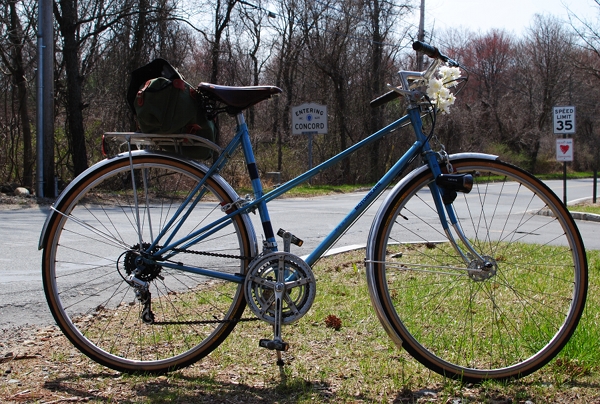 Here is
Here is  This is a popular cycling route in the Boston area. I first went through the Minuteman Trail and then cycled on the road (Route 62 W) for an additional 5.5 miles. At the end of the Minuteman Trail, I overheard a pair of road cyclists - dressed in full lycra and on super-high-tech bikes - discussing whether they should go to Concord or choose a different direction. One of them said that the route to Concord is really hilly and he didn't feel like dealing with that. This alarmed me, but I decided to start cycling in that direction anyway just to see how it is. If too hilly, I would simply turn back. Well, clearly that did not happen - which makes me wonder how to interpret the super-roadcyclist's comment. The terrain was completely manageable on a 12-speed bicycle.
This is a popular cycling route in the Boston area. I first went through the Minuteman Trail and then cycled on the road (Route 62 W) for an additional 5.5 miles. At the end of the Minuteman Trail, I overheard a pair of road cyclists - dressed in full lycra and on super-high-tech bikes - discussing whether they should go to Concord or choose a different direction. One of them said that the route to Concord is really hilly and he didn't feel like dealing with that. This alarmed me, but I decided to start cycling in that direction anyway just to see how it is. If too hilly, I would simply turn back. Well, clearly that did not happen - which makes me wonder how to interpret the super-roadcyclist's comment. The terrain was completely manageable on a 12-speed bicycle. Hills or no hills, I loved cycling on Route 62. There are few cars, plenty of shade even at mid-day, fresh air, and often a shoulder to cycle on. Along the way are farms, picturesque New England houses, old cemeteries, and stretches of woods. This is my dream landscape for touring, and I wonder whether Route 62 West continues to be just as nice further West? If you are local, please let me know.
Hills or no hills, I loved cycling on Route 62. There are few cars, plenty of shade even at mid-day, fresh air, and often a shoulder to cycle on. Along the way are farms, picturesque New England houses, old cemeteries, and stretches of woods. This is my dream landscape for touring, and I wonder whether Route 62 West continues to be just as nice further West? If you are local, please let me know.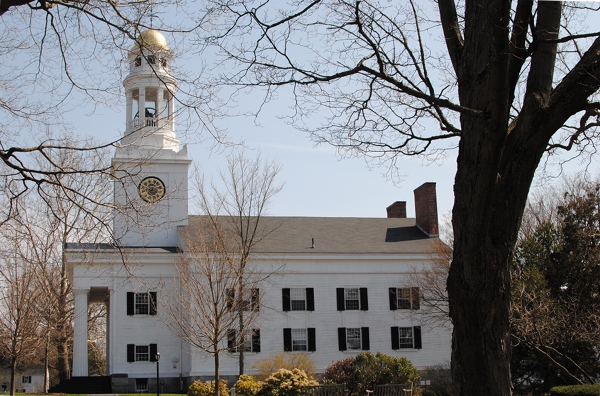 It took me about 1 1/2 hours to arrive to Concord center from my house, not counting a coffee stop along the way. Since it is an 18-mile route, this means I was going an average of 12 mph: slow and steady, which is probably a good way to start for someone like me.
It took me about 1 1/2 hours to arrive to Concord center from my house, not counting a coffee stop along the way. Since it is an 18-mile route, this means I was going an average of 12 mph: slow and steady, which is probably a good way to start for someone like me.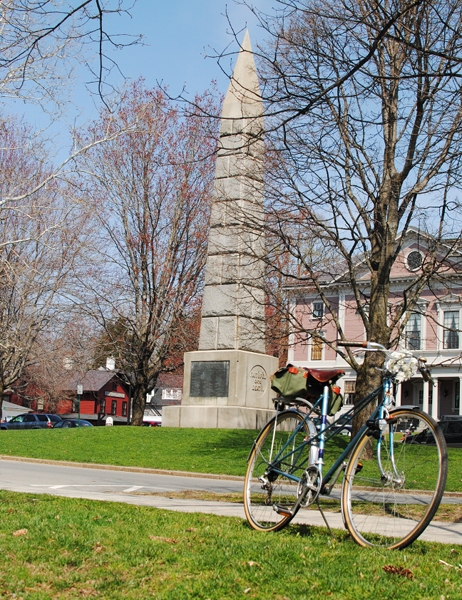 Concord, Massachusetts is a fascinating town from a historical perspective - having been home to Emerson, Thoreau and Hawthorne, among others. Its most famous site is probably Walden Pond, but I intentionally did not cycle in that direction because I want to visit it with the Co-Habitant. Instead, Marianne and I explored the town center.
Concord, Massachusetts is a fascinating town from a historical perspective - having been home to Emerson, Thoreau and Hawthorne, among others. Its most famous site is probably Walden Pond, but I intentionally did not cycle in that direction because I want to visit it with the Co-Habitant. Instead, Marianne and I explored the town center.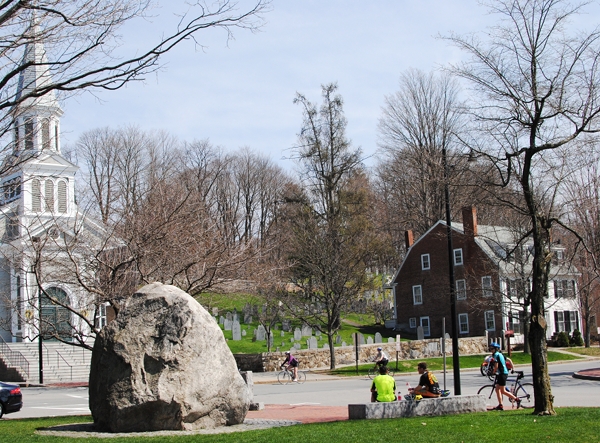 It was Easter Sunday, and the people out on the streets were an amusing mix of churchgoers in their Sunday best and cyclists in skin-tight black and neon lycra.
It was Easter Sunday, and the people out on the streets were an amusing mix of churchgoers in their Sunday best and cyclists in skin-tight black and neon lycra.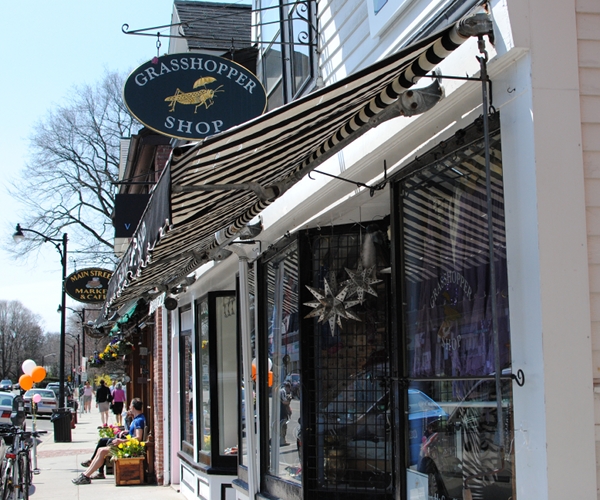 The mood in the town center was festive.
The mood in the town center was festive.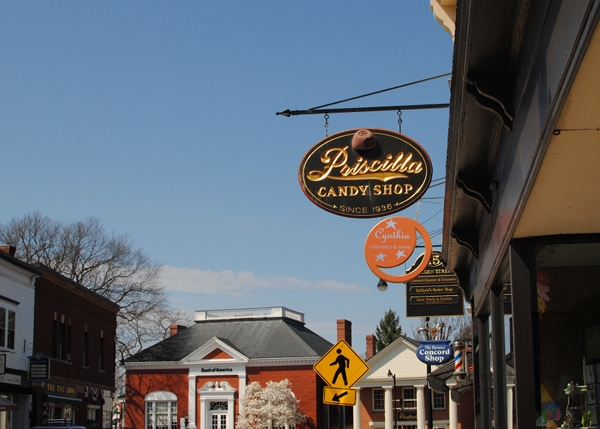 No businesses were open except for a couple of cafes, but it was fascinating just to walk around the streets and observe.
No businesses were open except for a couple of cafes, but it was fascinating just to walk around the streets and observe. For such a tiny town, Concord is home to a staggering number of churches. I think there were close to a dozen in the center alone.
For such a tiny town, Concord is home to a staggering number of churches. I think there were close to a dozen in the center alone. Aside from churches, I noticed an abundance of landmark signs that refer to things that were once in that spot, but no longer are: trees that have been felled, streams that have been drained and built upon, mills and historical homes that have been demolished, etc.
Aside from churches, I noticed an abundance of landmark signs that refer to things that were once in that spot, but no longer are: trees that have been felled, streams that have been drained and built upon, mills and historical homes that have been demolished, etc. There is a feeling of living in the past that the town seems to intentionally embrace - from the quaint storefronts on Main Street, to other nostalgic details here and there, like this antique bicycle next to a popular food market. I wonder whether the area around Walden Pond has a similar feel to it. Hopefully we will visit there soon.
There is a feeling of living in the past that the town seems to intentionally embrace - from the quaint storefronts on Main Street, to other nostalgic details here and there, like this antique bicycle next to a popular food market. I wonder whether the area around Walden Pond has a similar feel to it. Hopefully we will visit there soon. After spending about an hour and a half in Concord, I headed back - via Route 62 again and then the Minuteman Trail. Not much was in bloom along the trail yet, but it was good to be there for the first time since November. Despite it being Easter Sunday, the path was not too crowded and I returned home in good time.
After spending about an hour and a half in Concord, I headed back - via Route 62 again and then the Minuteman Trail. Not much was in bloom along the trail yet, but it was good to be there for the first time since November. Despite it being Easter Sunday, the path was not too crowded and I returned home in good time. For my first mini-tour involving road cycling and a specific destination, I thought this went well. I ate at well-spaced intervals and did not get tired. In general, I feel that my endurance of long rides is determined more by comfort than physical ability: pain begins to bother me before I have the chance to grow tired. In the past, the major problems were saddle discomfort (the Brooks Flyer Special refused to break in no matter what), handlebar discomfort (too much weight placed on the hands would result in pain), and generally feeling not entirely in control of this bicycle. The control problem has been solved now. And after the latest raising of the saddle, the Flyer feels much better. The handlebars remained an issue simply because the mountain bike hand position of the Milan bars is not good for long rides. My hands did not go numb during this trip, but I felt that it would happen soon if I kept going. I have now found a solution to this, and will write about it in the next post.
For my first mini-tour involving road cycling and a specific destination, I thought this went well. I ate at well-spaced intervals and did not get tired. In general, I feel that my endurance of long rides is determined more by comfort than physical ability: pain begins to bother me before I have the chance to grow tired. In the past, the major problems were saddle discomfort (the Brooks Flyer Special refused to break in no matter what), handlebar discomfort (too much weight placed on the hands would result in pain), and generally feeling not entirely in control of this bicycle. The control problem has been solved now. And after the latest raising of the saddle, the Flyer feels much better. The handlebars remained an issue simply because the mountain bike hand position of the Milan bars is not good for long rides. My hands did not go numb during this trip, but I felt that it would happen soon if I kept going. I have now found a solution to this, and will write about it in the next post. Last week we replaced the cloth tape on the Co-Habitant's Surly with Fizik Microtec tape. He wanted something that would not get dirty, did not require shellacking, and was not as heavily padded as cork tape.I've been using this tape in red for the past several weeks, so I suggested he try it. We both purchased it at Harris Cyclery, but it's available in many bike shops.
Last week we replaced the cloth tape on the Co-Habitant's Surly with Fizik Microtec tape. He wanted something that would not get dirty, did not require shellacking, and was not as heavily padded as cork tape.I've been using this tape in red for the past several weeks, so I suggested he try it. We both purchased it at Harris Cyclery, but it's available in many bike shops.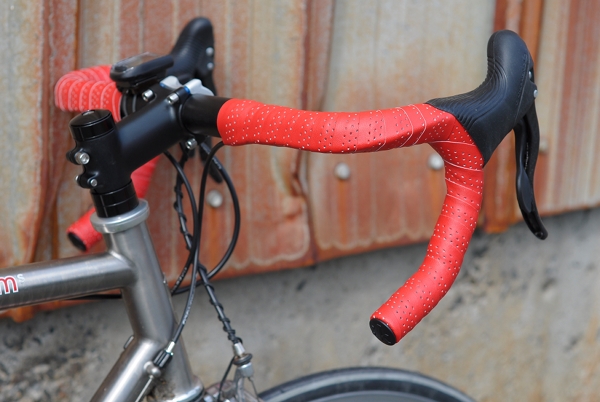 FizikMicrotec bar tape is a synthetic tape with about half the padding of typical cork tape. The perforated surface is smooth, but not slippery. It lies down flat, the edges resist fraying, and the surface stays clean. I know some complain that cloth and cork tape tend to get dirty and frayed, so if you want a bright handlebar tape that is durable and retains its colour, this could be it. Mine looks and feels the same after 300+ miles of sweaty gripping as it did when first installed. But more importantly, this tape could work for those who find cork tape too soft and cloth tape too hard - it is sort of the happy medium.
FizikMicrotec bar tape is a synthetic tape with about half the padding of typical cork tape. The perforated surface is smooth, but not slippery. It lies down flat, the edges resist fraying, and the surface stays clean. I know some complain that cloth and cork tape tend to get dirty and frayed, so if you want a bright handlebar tape that is durable and retains its colour, this could be it. Mine looks and feels the same after 300+ miles of sweaty gripping as it did when first installed. But more importantly, this tape could work for those who find cork tape too soft and cloth tape too hard - it is sort of the happy medium.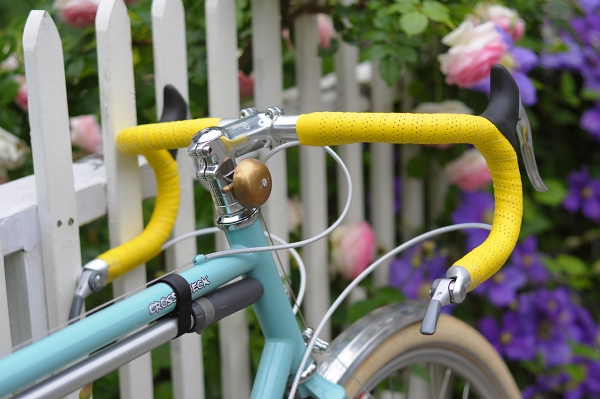 Although visually the perforations resembleleather tape, there are no tactile similarities. The Fizik tapeis stiffer than leather, and it feels distinctly synthetic to the touch. While I would not describe the surface as slick, I can see how some might find it too smooth - especially if riding without gloves. My preferred handlebar wrap is cloth tape, but on some handlebars - particularly on modern ones that have channels for cables - I feel that I need more padding. The Fizik Microtex tape is durable, easy to wrap, provides just enough padding, and is available in a variety of colours.
Although visually the perforations resembleleather tape, there are no tactile similarities. The Fizik tapeis stiffer than leather, and it feels distinctly synthetic to the touch. While I would not describe the surface as slick, I can see how some might find it too smooth - especially if riding without gloves. My preferred handlebar wrap is cloth tape, but on some handlebars - particularly on modern ones that have channels for cables - I feel that I need more padding. The Fizik Microtex tape is durable, easy to wrap, provides just enough padding, and is available in a variety of colours.
